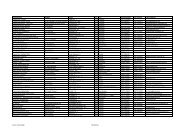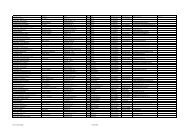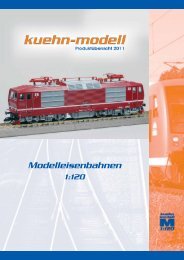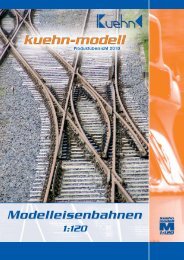NMRA-DCC/Motorola Locomotive Decoder with Load Control - Kuehn
NMRA-DCC/Motorola Locomotive Decoder with Load Control - Kuehn
NMRA-DCC/Motorola Locomotive Decoder with Load Control - Kuehn
Create successful ePaper yourself
Turn your PDF publications into a flip-book with our unique Google optimized e-Paper software.
2 Instruction manual T125/T145<br />
Please note : This decoder is not suitable for operation <strong>with</strong> conventional AC<br />
supply and the voltage pulse for change the direction! The high voltage of this pulse<br />
will cause the destruction of the decoder.<br />
2. Safety instructions<br />
This product is not a toy! Not suitable for children under 14 years. Not suitable for<br />
children under 3 years because of danger of their swallowing the small<br />
constituent pieces! At an incorrect use there exist a danger of hurting because of<br />
cutting edges and tips. Please retain these instructions for further reference.<br />
3. Installing the decoder<br />
3.1. Preparation<br />
Only locomotives, which run smoothly in analogue mode, should be equipped <strong>with</strong> a<br />
digital decoder. A secure and uninterrupted current pickup is important especially in<br />
digital mode. Change worn coal brushes and defect lights and clean wheel pick-ups. The<br />
decoder should be installed inside the locomotive in such a way as to avoid overheating.<br />
Tools : For installing the decoder please use a soldering iron <strong>with</strong> 30 Watts max. (if<br />
possible <strong>with</strong> temperature control), electronic solder (no soldering paste), side cutters (to<br />
shorten the leads) and small screw drivers. You also need insulation tape (to cover any<br />
metal parts of the locomotive) and double sided tape to fasten the decoder.<br />
Before installing the decoder you have to completely insulate the motor, which means<br />
there should not be any electrical connection between motor and wheel pick-up. Don’t<br />
forget which motor terminals were connected <strong>with</strong> the right or left wheel pick-up.<br />
Advice for older Fleischmann locomotives: Often in these locomotives the motor<br />
shield is part of the motor’s power supply and therefore connected <strong>with</strong> one of the wheel<br />
pick-ups. To insulate the motor you have to cut off this connection or replace the motor<br />
shield.<br />
3.2. Maximum current load capacity<br />
Besides the desired functions and the available installation space the current draw of the<br />
motor under full load determines the selection of a suitable decoder.<br />
The decoder supplies a motor current of 1.1 A. Values regarding current draw of locos<br />
generally refer to a voltage of 12 or 14 Volts. Is the digital voltage of your command<br />
station higher (e.g. Roco “Lokmaus”, LGB, Intellibox), the current rises and could<br />
potentially exceed the permitted value of 1.1A. For operating H0 gauge we recommend a<br />
track voltage of 16 V.<br />
The total current load capacity of the decoder in digital mode is 1.2 A. If the motor draws<br />
e.g. 1.0 A, then the total current available for all light and function outputs is 200mA. The<br />
partitioning of the current for example could look like this: For directional headlight<br />
50mA (outputs A and B), output C=50mA (e.g. for interior lighting). Then at output D






